WILL WE EVER REALLY KNOW WHAT HAPPENED AT FIREBIRD?
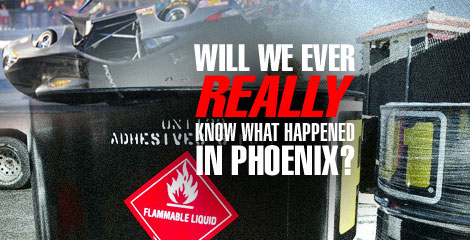 Firebird International Raceway operator Charlie Allen said he has lost five pounds this month and might lose another $250,000, as well, to repave his dragstrip.
Firebird International Raceway operator Charlie Allen said he has lost five pounds this month and might lose another $250,000, as well, to repave his dragstrip.Pro Stock drivers Gordie Rivera and Vinnie Deceglie each have lost race cars that cost six figures apiece.
P.J. Harvey lost control of what happened with the traction compound he manufactures and distributes.
And the NHRA, already reeling from an unrelated Top Fuel crash after which a spectator lost her life, is at a loss to explain exactly what happened to force postponement of the Feb. 21 Arizona Nationals Pro Stock eliminations until this weekend at Gainesville, Fla.
Lots of finger-pointing, So few confirmed facts …
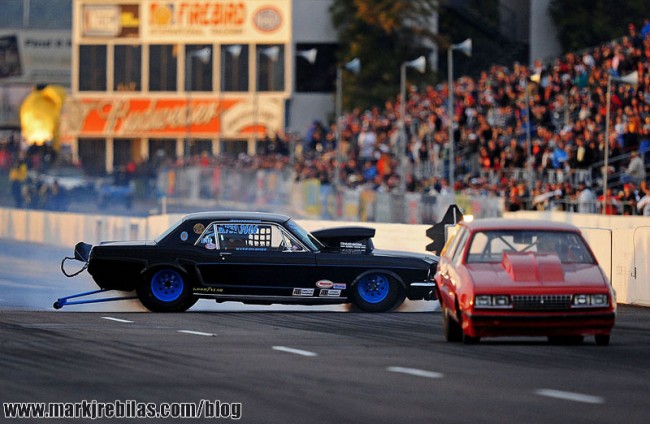
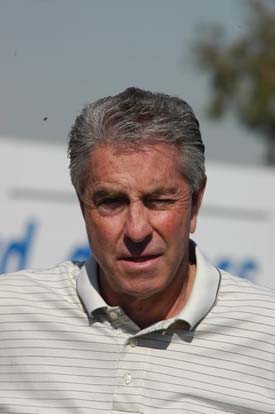
Pro Stock drivers Gordie Rivera and Vinnie Deceglie each have lost race cars that cost six figures apiece.
P.J. Harvey lost control of what happened with the traction compound he manufactures and distributes.
And the NHRA, already reeling from an unrelated Top Fuel crash after which a spectator lost her life, is at a loss to explain exactly what happened to force postponement of the Feb. 21 Arizona Nationals Pro Stock eliminations until this weekend at Gainesville, Fla.
Additionally, the NHRA also called off the Division 7 Lucas Oil Drag Racing Series opener at the Phoenix-area racetrack because of another accident it said was traced to incorrect or compromised traction compound. That race also will be rescheduled at a time as yet to be determined.
While the investigation into Antron Brown's dragster accident continues and John Force Racing safety shaman John Medlen works with Brown's Don Schumacher Racing team to develop wheel tethers on fuel cars or another effective solution, the NHRA has taken steps to help the Pro Stock class. It ordered specs that must be in place by this weekend's Tire Kingdom Gatornationals at Gainesville, Fla.
Meanwhile, the sanctioning body still is trying to sort out what was happening with the track surface at Firebird, a stop on the NHRA tour for 26 years.
Traction compound appears to be the culprit at this point, but several official sources involved have varying accounts about how an improper compound wound up on the track -- or whether tainted or incorrect VHT-trademarked solution (recently renamed "PJ1" by Harvey's company, P.J. Brands) was applied to the track at all.
article continues after advertisement
Click to visit our sponsor's website
Liability, embarrassment, pride, ignorance, or human nature ultimately might prevent the full truth from surfacing publicly. But NHRA Division 7 Director Mike Rice said he's optimistic that "I think we will" know someday soon what happened at Phoenix in the past two months. Rice has faith, but Graham Light, the NHRA's senior vice-president of racing operations, said, "There are still a lot of unexplained things."
Allen, who said seeing Rivera crash, then watching Deceglie flip over "was terrifying for me," said he is willing to talk because "I am anxious to have the truth out."
Said Allen, "I know how to prepare a track. I believe we have the best people preparing our track. Robert Hight (the reigning Funny Car champion) told me [during the so-called National Time Trials preseason test session] the track was the best it had been in 25 years."
So what happened at the preseason National Time Trials and at the back-to-back Arizona Nationals and Division 7 races?
Harvey admitted, "We dropped the ball with delivering a product."
But the scope of that error is at the heart of the matter. The stories don't match.
a d v e r t i s e m e n t
Click to visit our sponsor's website
HE SAID – HE SAID – HE SAID
Indisputable are three things: (1) Two Pro Stock cars overturned during qualifying for the Arizona Nationals, (2) Light gathered first-round Pro Stock winners and suggested that they finish their eliminations during the Gatornationals (to which they agreed), and (3) Super Gas and Super Comp cars at the following week's Division 7 event struggled to get down the track, forcing officials of the event, in its second day, to halt the race until further notice.
LIGHT: CHANGES TO PRO STOCK NOT BASED SOLELY ON PHOENIX
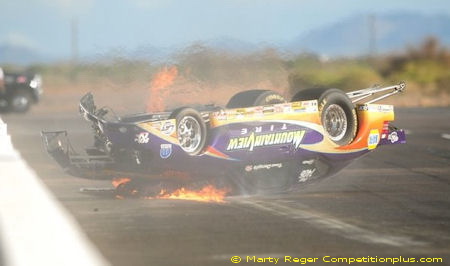 Pro Stock driver Greg Anderson shared his strong opinion of the Firebird International Raceway surface conditions at the recent NHRA Arizona Nationals with the ESPN television audience. However, the presentation of his tirade, which wasn't unjustified, appeared to imply that the Pro Stock drivers revolted and made demands to the NHRA to finish their eliminations at the upcoming Gatornationals.
Pro Stock driver Greg Anderson shared his strong opinion of the Firebird International Raceway surface conditions at the recent NHRA Arizona Nationals with the ESPN television audience. However, the presentation of his tirade, which wasn't unjustified, appeared to imply that the Pro Stock drivers revolted and made demands to the NHRA to finish their eliminations at the upcoming Gatornationals.
It didn't quite happen that way.
Graham Light, NHRA senior vice-president of racing operations, and Dan Olson, director of Top Fuel and Funny Car racing, worked during qualifying to identify the problems that cause two Pro Stock cars to end up on their lids and give the rest of the field serious concerns. Said Anderson that Friday night, "They want to fix it as well, but they’re not sure what it is, either."
In postponing the Division 7 event, Rice issued a statement on behalf of NHRA, after receiving input from Allen and Firebird track manager Chuck Sunstrom. In part, the Saturday, Feb. 27 memo (posted on Drag RaceCentral.com) read:
"NHRA and Firebird officials have been working feverishly to correct a problem that was discovered during the NHRA Arizona Nationals and despite their best efforts have not been able to overcome the conditions. It was found on Friday that the wrong product of traction compound was sent to the track and was used to prepare the racetrack the last two weeks. Officials believe that this is the root of the problems with the racing surface.
"In the best interests of safety and concern for attending competitors, officials feel this is the best decision that can be made. The remainder of the event will continue at a later date that will be announced in the near future."
That statement affirms that improper traction compound was applied to the track at both the national and divisional events. But Harvey said that is not the case.
Firebird International Raceway houses three road-racing courses, in addition to the dragstrip. Speculation is that "oval-track traction compound" meant for another course at Firebird ended up at the dragstrip.
"There was a bad batch that was prepared and sent to Arizona. I learned that when it was on the road that it didn't meet spec and someone let it go. I stopped it immediately when it got to Arizona," Harvey said, adding that he instructed the track to have it "set off to the side."
He insisted, "It was never touched, eight drums, sitting on two pallets. Then, within a day or so, I had it picked up and returned. It was never used. That product was shipped there and was identified before it was ever delivered to the track. It was isolated and returned to the plant."
Light said that the drums were "labeled that would indicate it was the right stuff. It was one pallet that was blended incorrectly that didn't meet the spec for drag racing. It was for a different purpose. From what everybody tells me, it was not used at the national event but some of it DID get used, allegedly, at the points race.
Rice said, "I can tell you for sure that it was used at the divisional event."
According to Rice, Harvey told Dan Olson, NHRA's director of Top Fuel and Funny Car racing, that the compound at the Arizona Nationals was fine. So that explains why Light had been assured that the traction compound was not used at the national event.
Said Light, "Here's what I know, what we've found so far: For the warm-up [referring to the preseason test session] there was a pallet that drop-shipped that was not drag-racing formula. It was for another use, I believe oval track in some application. It did not get used during the national event, but one drum supposedly was used for the points [Division 7] race.
"The difficulty I'm having in my mind," Light said, "is why we had express problems at the national event. Those are unanswered questions at this point.
"We're still getting some chemical analyzed. A bunch of it has been analyzed already and proven that it meets all the VHT manufacturing specs. So right now I don't have any answers for you," he said. "There's some thought possibly that the drums that were pre-mixed -- you can either buy VHT 100 percent or we've been getting some that has been premixed 75-25. There's a thought that possibly with the rain that the alcohol, the methanol in those drums, 25 percent, we do know that methanol absorbs moisture, that possibly the chemical has a certain content of moisture in it. We don't know that for a fact. That's one theory.
"I don't know," Light said. "We're still kind of scratching our heads and looking at everything possible, evaluating and getting samples tested, to see if we can find out what the heck happened.
"From what I'm told by VHT [Harvey], they discovered that when they shipped the stuff to the warm-up prior to the Winternationals and thought that it was all returned to VHT and replaced," Light said. "But at the points race, P.J. Harvey discovered that some chemical that was . . . I don't know if it was from that original pallet that was shipped or how it got there, but it was there. Again, he assures us that it was not used at the national event."
The Firebird folks said it wasn't used at the preseason test session, a fact everyone agrees on.
Allen told Attitude's Competition Plus that Sunstrom and track starter Steve Cooper watched Harvey mark the drums on Friday morning of the Division 7 event and took photos of him with the drums. Harvey, according to Allen, said the problem occurred because of "wrong batch codes."
(Telling one type of VHT from another is difficult, Allen said: "It all smells basically the same. It looks the same." Cooper said, "Oval VHT is more yellowish in color. One-hundred percent drag racing VHT is more greenish. They are really difficult to tell apart. Sometimes you can see it and sometimes you can smell it.")
Sunstrom said the Firebird personnel "got lucky" at the preseason test session. "If it hadn't rained," he said, "we would have started using product from the eight drums of VHT delivered for the test-and-tune. Fortunately, we got a call telling us not to use the drums delivered, and we prepped the track with two drums we had left over from December.
"The eight drums we had were replaced with eight new drums. And we didn't have any problems, other than weather, at the test-and-tune. Everybody told us the track was the best they had seen it during the test and tune. John Force ran his fastest times ever to 1,000 feet."
It's undetermined still whether the improper VHT was used at the national event.
"To be perfectly honest with you, I don't know," Rice said. "I think it was. Charlie thought it was -- he wanted that in the [Feb. 27] statement. P.J. swears it wasn't used at the national event."
The day before the Division 7 event, test-and-tune activities stopped when the Super Gas car flipped. Firebird employees dragged the track until 9 p.m. Rice continued the process until midnight.
The next day, Rice said, he soaked the track with straight methanol, washed it with water and Tide detergent, and re-prepped the track as he would have under normal conditions. Cars continued to run. Saturday morning's activities began routinely until some Super Comp and Super Gas cars started to show some difficulty getting down the track.
"A few had some hairy rides, but nobody touched the wall," Rice said. Alcohol cars, motorcycles, and the Stock and Super Stock classes had no problems with either lane. Still, once they realized they accidentally had been spraying VHT from a "banned" barrel -- which, according to Harvey, had been sent back to the plant long before that -- the NHRA suspended the event.
"Safety's No. 1," Rice said. "I think everybody understood. The vast majority of e-mails and phone calls [from sportsman racers] was along the lines of 'Thank you for looking out for us.' It was the right thing to do."
Allen agreed. "We were trying everything we knew. Mike Rice was trying everything he knew," he said. "The time and weather finally caught up with us. Stopping the event was the right thing to do."
If, as Harvey insisted, the improper VHT never was used at any of the three Firebird events in question, how can he justify that position? He said it bothers him tremendously that the accidents at Firebird are being linked to his traction compound.
"You bet it does," Harvey said. "That's why I spent two days going over the records and tests of the product before it was shipped. You bet it does. I wanted to make sure we were right before I responded to it [the rumor]. No question about it. I take it very seriously. Very seriously. How can you not take it serious?”
a d v e r t i s e m e n t
Click to visit our sponsor's website
“IT’S NOT OUR FIRST RODEO”
 What baffles Light is this riddle: If the improper VHT was not used at the Arizona Nationals but used at the Division 7 event, why did the on-track troubles from the national event seem to resemble those at the divisional event?
What baffles Light is this riddle: If the improper VHT was not used at the Arizona Nationals but used at the Division 7 event, why did the on-track troubles from the national event seem to resemble those at the divisional event?
"We had similarities in what was happening at the points race and the national event, which is very puzzling to me," Light said. "I'm being told by the VHT people, by our people, that it was not used at the national event. It's confusing. We're still trying to get answers and trying to sort this out. We're at a loss right now."
On one hand, Light said, "The vast majority of cars didn't crash. Hundreds and hundreds of runs went down that racetrack, and a couple of those cars crashed out of those hundreds or thousands of runs. Is it the fault of the track? Is it the fault of the prep? Is it a fault of the components of the cars? Is it the fault of the drivers? Everybody has their theories. It's human nature to point fingers at somebody else."
"It's frustrating as hell, because it's easy to fix the problem if you know what caused the problem. If you don't know what caused it, it becomes very frustrating," Light said. "We have a lot of people who have done this a long time. It's not our first rodeo. All of our people and the VHT (owner) and the track operator and everybody kind of scratched their heads, trying to figure out what the hell is going on. And nobody has been able to pinpoint it at this point.
Backing up what Allen and others have said, "Even the fuel guys told us that it was one of the best racetracks they've seen, as far as traction goes. They told Dan Olson this was as good as they've seen it anywhere," Light said. "The fuel cars had no problem. The alcohol cars had no problem at the points race. Those are things that are very confusing. Yes, we know the Pro Stock [class] on down has less downforce. But when you're hearing from the fuel teams that this is as good as it gets, it doesn't add up."
a d v e r t i s e m e n t
Click to visit our sponsor's website
IS FIREBIRD SALVAGEABLE?
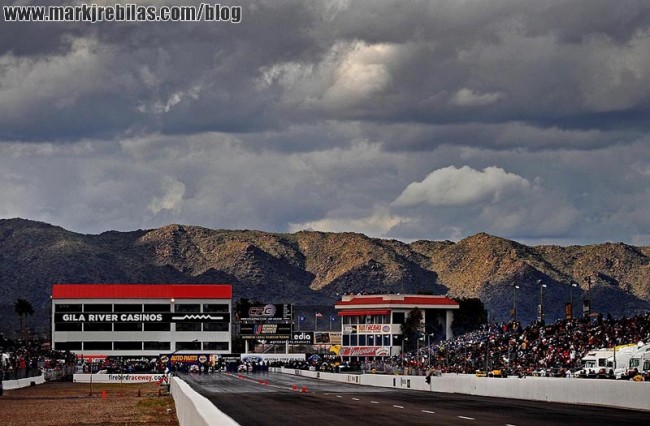
SO WHAT MAKES VHT INAPPROPRIATE? To understand some of the factors in the Phoenix VHT / Pro Stock accidents equation, it's necessary to know how the NHRA applies traction compound, what guidelines it uses.
To understand some of the factors in the Phoenix VHT / Pro Stock accidents equation, it's necessary to know how the NHRA applies traction compound, what guidelines it uses.
Graham Light, the NHRA's senior vice-president of racing operations, said prepping the track for a national event is a bit of a combination of NHRA racing-surface experts and their local-track counterparts.
"We request that the track scrape all the old rubber off the track from the starting line to approximately 500 foot. And our people will show up, normally the weekend before. Sometimes we have to touch up the scraping job. Other times we don't. Bottom line, you try and get as much of the old rubber off as possible," he said.
READ THE FULL STORY ...
"Everywhere we race is unique," Light said. "I guess in the perfect world, every racetrack out there would have a brand-new, perfectly flat surface every year. We know that's impossible."
Moreover, he said, that's not necessarily a warranty that cars wouldn't crash or cause problems for the racers.
"We've had brand-new racetracks that have been challenging," he said, pointing to the NHRA-owned Atlanta Dragway, which misbehaved a few years ago, even after repaving. Beautifully manicured Bristol Dragway also had its problems recently.
"A brand-new surface doesn't necessarily guarantee it's going to be excellent, either," Light said. "There are some specs in the concrete mixture. There are specs in the asphalt mixture. If they are closely adhered to in every load of asphalt and if every load of concerete is personally inspected, you run a better chance of the surface being correct. Sometimes not every load is inspected. Sometimes the oil content in the asphalt may be greater or once in awhile the water content in the concrete may be more than what the spec calls for, and you end up with a difficult surface."
Besides, Firebird has been good enough to produce Tony Pedregon's now-mothballed quarter-mile national elapsed-time record of 4.659 seconds, as well as the currently recognized 4.023-second 1,000-foot mark that Ron Capps set there in February 2009.
"Sometimes," Light said, "a tried, proven surface can last for years and you're better off not to dig it up and replace it."
But does the NHRA consider Firebird a substandard facility?
"I'm not going to tell you that any of our tracks are substandard," Light said.
He said the Phoenix market, one of the fastest-growing cities in the U.S. before the economy went sour, is one "that we need to take our sponsors to."
Furthermore, Light seem surprised to learn that a rumor was floating about that the NHRA has told Firebird to fix its problems or risk its sanction being revoked. He said that talk hadn't occurred -- "not any conversation I've had. I don't know if anybody else has had that."
Rice said it was news to him.
Said Light, "We work with all of our track operators to try and raise the bar at every facility. I think the track operators have proved year in and year out that they have invested money in concrete retaining walls, tower suites, track surfaces, electronics. Are all racetracks perfect? No, not by a long means. I think, though, there has been a tremendous investment by each independent track operator out there over the years to upgrade their facilities.
"The maintenance costs for each facility is tremendous yearly," he said. "When you start looking at capital expenditures, they're substantial. If you look at the emergency runoff traps in the last two years, you're talking millions and millions of dollars that tracks have spent. That's money that's invested that doesn't draw another sponsor, another spectator, another ticket-buying customer. But it's necessary. And they responded."
At the same time, Light acknowledged that the Firebird facility needs improvement.
"We know there are some bumps at the track that have to be corrected. We know that the asphalt has deteriorated over time, as all racetrack do. We think taking the bumps out is going to help immensely," he said. "Charlie's fully aware of that and fully prepared to make it right."
Allen said, "The concrete looks good. We've got to be careful scraping the asphalt. It's delicate. You can ruin the asphalt doing it wrong. We might have to repave at a cost of $250,000 or more."
The reason has nothing to do with the February VHT mix-ups. While Allen has his checklist of improvements to make, so does the NHRA. It must unravel the mystery of what happened with the traction compound so that does not become a factor in the integrity of its track preparation.
| {loadposition feedback} |







